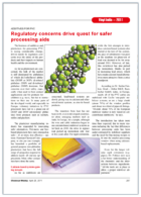Interviews
29.04.2011
Interview with Dr. Stefan Fokken, Head – Global R&D
Regulatory concerns drive quest for safer processing aidsThe business of additives and plasticisers for processing PVC is seeing considerable change, driven mainly by regulatory concerns over the safety of the products and their impacts on human health and the environment. As far as plasticisers are concerned, the bulk of the market is still dominated by phthalates of which di-2-ethylhexyl phthalate (DEHP or DOP), di-n-butyl phthalate (DBP) and di-isobutyl phthalate (DIBP) dominate. But concerns over their safety, especially when used in food contact applications and for products for children (e.g. toys), has led to restrictions on their use. In many parts of the developed world, and especially in Europe, voluntary initiatives by PVC processors have led to a phase-out of DEHP and DINP (di-isononyl phthalate) from products such as teethers, rattles and pacifiers. The plasticizer manufacturing industry has responded by innovating safer alternatives. Polymeric and biobased plasticisers have now emerged as safer – if, at times, less effective – options. Eastman Chemical Company, to cite just one example, has launched a portfolio of general purpose non-phthalate plasticisers that have the full range of properties required to address nearly all end-use applications. Many other companies have done the same.Calcium-based systems gaining inroads
As far as stabilizers are concerned, lead-based systems are slowly giving way to calcium and other mixed metal systems, as also tin based products. The transition from lead has not been swift, even in developed countries, let alone emerging markets such as India. In Europe, for example, although the wire and cable industries began to use calcium-based stabilizer systems as far back as 2000, the drive to replace lead picked up momentum only four or five years after. For rigid extrusions, while the first attempts to introduce calcium-based systems also started at the turn of the century, the pace of substitution was poor as the deadline for phase-out of lead was deemed to be far away around 2011. However, of late, this switchover has also picked up momentum, thanks in part to increasing lead prices, which have made calcium based alternatives more attractive from a price standpoint. According to Dr. Stefan Fokken, Head – Global R&D, Baerlocher GmbH, today, in Europe, nearly all of the PVC cables are stabilized with Ca-Zn ‘one-pack’ stabilizer systems, as are a large chunk (about 70%) of the window profiles and about two-third of pipes & fittings. “Overall, about 70% of the European stabilizer market is now based on calcium- based stabilizers,” he says. The introduction has taken more time than expected, due to many reasons including the fact that differences between processing units has been under-estimated by stabilizer suppliers and the need for fine-tuning recipes to fit into the smaller processing window when using calciumbased replacements. Even for the larger volume rigid extrusions (e.g. pipes), Dr. Fokken now sees a far better understanding of the chemistry and the interactions between ingredients. “All the tools are in place to allow a proper stabilizer adjustment.”



